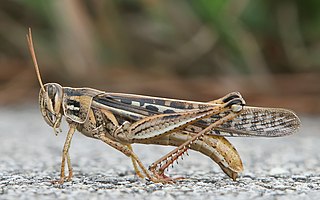
Orthoptera is an order of insects that comprises the grasshoppers, locusts, and crickets, including closely related insects, such as the bush crickets or katydids and wētā. The order is subdivided into two suborders: Caelifera – grasshoppers, locusts, and close relatives; and Ensifera – crickets and close relatives.

Locusts are various species of short-horned grasshoppers in the family Acrididae that have a swarming phase. These insects are usually solitary, but under certain circumstances they become more abundant and change their behaviour and habits, becoming gregarious. No taxonomic distinction is made between locust and grasshopper species; the basis for the definition is whether a species forms swarms under intermittently suitable conditions; this has evolved independently in multiple lineages, comprising at least 18 genera in 5 different subfamilies.

The Rocky Mountain locust is an extinct species of grasshopper that ranged through the western half of the United States and some western portions of Canada with large numbers seen until the end of the 19th century. Sightings often placed their swarms in numbers far larger than any other locust species, with one famous sighting in 1875 estimated at 198,000 square miles (510,000 km2) in size, weighing 27.5 million tons and consisting of some 12.5 trillion insects, the greatest concentration of animals ever speculatively guessed, according to Guinness World Records.

Grasshoppers are a group of insects belonging to the suborder Caelifera. They are amongst what are possibly the most ancient living groups of chewing herbivorous insects, dating back to the early Triassic around 250 million years ago.

Bandwings, or band-winged grasshoppers, are the subfamily Oedipodinae of grasshoppers classified under the family Acrididae. They have a worldwide distribution and were originally elevated to full family status as the Oedipodidae. Many species primarily inhabit xeric weedy fields, and some are considered to be important locusts:

The Caelifera are a suborder of orthopteran insects. They include the grasshoppers and grasshopper-like insects, as well as other superfamilies classified with them: the ground-hoppers (Tetrigoidea) and pygmy mole crickets (Tridactyloidea). The latter should not be confused with the mole crickets (Gryllotalpidae), which belong to the other Orthopteran sub-order Ensifera.

The Barkly Tableland is a region in the Central East if the Northern Territory, extending into Western Queensland. The region was named after Sir Henry Barkly. The epithet “Tableland” is inaccurate, since the region is neither elevated relative to adjacent landforms, nor are the boundaries marked by a distinct change in elevation.

The Dulit frogmouth is a little-known species of bird in the frogmouth family, Podargidae, with a patchily recorded distribution in the mountain forests of northern and central Borneo to which it is endemic. The species is monotypic.

Kosher locusts are varieties of locust deemed permissible for consumption under the laws of kashrut. While the consumption of most insects is forbidden under the laws of kashrut, the rabbis of the Talmud identified eight kosher species of locust. However, the identity of those species is in dispute. The Jewish communities of Yemen and parts of northern Africa, until their emigration in the mid-20th century, ate locusts which according to their tradition are kosher. Some such species can be bought in Israel for consumption. In 2020, the National Rabbinate of Israel approved locusts as kosher (Pareve) for the first time: after inspecting and ensuring that modern agriculture technologies developed by Hargol FoodTech provide only kosher approved locusts species. The company sells its locusts and other food products fortified by locust protein under a special brand "Holy Locust"

Metarhizium acridum is the new name given to a group of fungal isolates that are known to be virulent and specific to the Acrididea (grasshoppers). Previously, this species has had variety status in Metarhizium anisopliae ; before that, reference had been made to M. flavoviride or Metarhizium sp. describing an "apparently homologous and distinctive group" of isolates that were most virulent against Schistocerca gregaria in early screening bioassays.

Valanga nigricornis, the Javanese grasshopper, is a species of grasshopper in the subfamily Cyrtacanthacridinae of the family Acrididae. It is found in southeastern Asia, the type location being Singapore. It was first described by the German zoologist Hermann Burmeister in 1838. There are more than twenty subspecies, most of which are endemic to different island groups; the subspecies V. nigricornis nigricornis is the type for the genus Valanga.

Valanga irregularis belongs to the family Acrididae. The distribution is restricted in the Australian tropics and subtropics. The species is the largest grasshopper of the continent. Usually the animal lives a solitary mode of life.

Buforania rufa, sometimes called the rufous toadhopper, is a spur-throated grasshopper native to Western Australia.

Adlappa is a monotypic genus of grasshoppers belonging to the family Acrididae. The only species is Adlappa erythroptera.

Kakaduacris minuta is a species of short-horned grasshopper in the family Acrididae. It is the only species in the genus Kakaduacris. It is found in north Australian savannas.

Stenocatantops vitripennis is a species of short-horned grasshopper in the family Acrididae. It is found in north Australian savannas in the wet season.

Bermiella is a genus of short-horned grasshopper in the family Acrididae. It is found mostly in Top End Australian savannas near watercourses and billabongs etc.

Tolgadia is a genus of short-horned grasshopper in the family Acrididae. It is found in north Australian savanna forest and woodland sites. The genus includes:

Ecphantus quadrilobus, also known as the crested tooth-grinder, is a genus of short-horned grasshopper in the family Acrididae. It is found mostly in Top End Australian savannas, especially in more arid areas around the Barkly Tablelands. When handled it makes a defensive whining sound by rubbing the mandibles together. E. quadrilobus is particularly found on solanaceous plants.




















